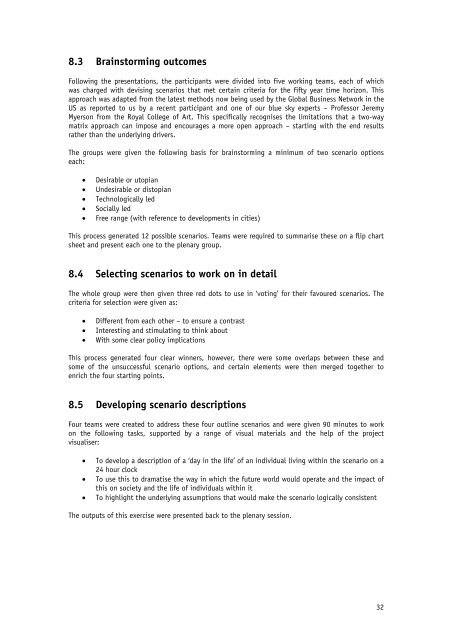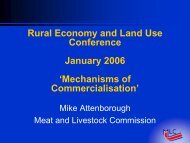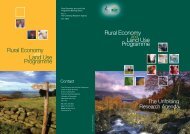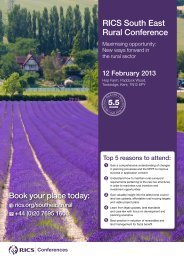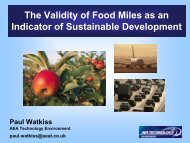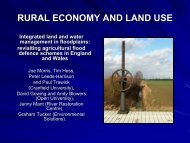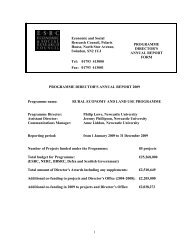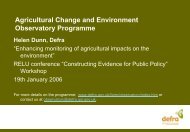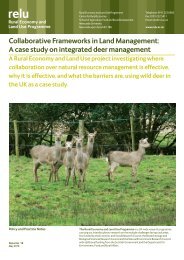Future Society in 2024: 21st Century 'Good Life' - Rural Economy ...
Future Society in 2024: 21st Century 'Good Life' - Rural Economy ...
Future Society in 2024: 21st Century 'Good Life' - Rural Economy ...
Create successful ePaper yourself
Turn your PDF publications into a flip-book with our unique Google optimized e-Paper software.
8.3 Bra<strong>in</strong>storm<strong>in</strong>g outcomes<br />
Follow<strong>in</strong>g the presentations, the participants were divided <strong>in</strong>to five work<strong>in</strong>g teams, each of which<br />
was charged with devis<strong>in</strong>g scenarios that met certa<strong>in</strong> criteria for the fifty year time horizon. This<br />
approach was adapted from the latest methods now be<strong>in</strong>g used by the Global Bus<strong>in</strong>ess Network <strong>in</strong> the<br />
US as reported to us by a recent participant and one of our blue sky experts – Professor Jeremy<br />
Myerson from the Royal College of Art. This specifically recognises the limitations that a two-way<br />
matrix approach can impose and encourages a more open approach – start<strong>in</strong>g with the end results<br />
rather than the underly<strong>in</strong>g drivers.<br />
The groups were given the follow<strong>in</strong>g basis for bra<strong>in</strong>storm<strong>in</strong>g a m<strong>in</strong>imum of two scenario options<br />
each:<br />
•<br />
•<br />
•<br />
•<br />
•<br />
Desirable or utopian<br />
Undesirable or distopian<br />
Technologically led<br />
Socially led<br />
Free range (with reference to developments <strong>in</strong> cities)<br />
This process generated 12 possible scenarios. Teams were required to summarise these on a flip chart<br />
sheet and present each one to the plenary group.<br />
8.4 Select<strong>in</strong>g scenarios to work on <strong>in</strong> detail<br />
The whole group were then given three red dots to use <strong>in</strong> ‘vot<strong>in</strong>g’ for their favoured scenarios. The<br />
criteria for selection were given as:<br />
•<br />
•<br />
•<br />
Different from each other – to ensure a contrast<br />
Interest<strong>in</strong>g and stimulat<strong>in</strong>g to th<strong>in</strong>k about<br />
With some clear policy implications<br />
This process generated four clear w<strong>in</strong>ners, however, there were some overlaps between these and<br />
some of the unsuccessful scenario options, and certa<strong>in</strong> elements were then merged together to<br />
enrich the four start<strong>in</strong>g po<strong>in</strong>ts.<br />
8.5 Develop<strong>in</strong>g scenario descriptions<br />
Four teams were created to address these four outl<strong>in</strong>e scenarios and were given 90 m<strong>in</strong>utes to work<br />
on the follow<strong>in</strong>g tasks, supported by a range of visual materials and the help of the project<br />
visualiser:<br />
• To develop a description of a ‘day <strong>in</strong> the life’ of an <strong>in</strong>dividual liv<strong>in</strong>g with<strong>in</strong> the scenario on a<br />
24 hour clock<br />
• To use this to dramatise the way <strong>in</strong> which the future world would operate and the impact of<br />
this on society and the life of <strong>in</strong>dividuals with<strong>in</strong> it<br />
• To highlight the underly<strong>in</strong>g assumptions that would make the scenario logically consistent<br />
The outputs of this exercise were presented back to the plenary session.<br />
32


